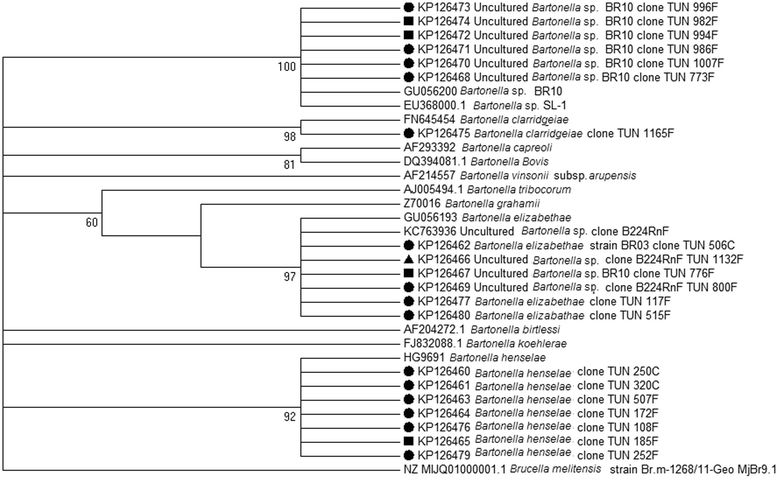First molecular detection and characterization of zoonotic Bartonella species in fleas infesting domestic animals in Tunisia
- PMID: 28927427
- PMCID: PMC5606017
- DOI: 10.1186/s13071-017-2372-5
First molecular detection and characterization of zoonotic Bartonella species in fleas infesting domestic animals in Tunisia
Abstract
Background: Bartonellosis is an emerging vector-borne disease caused by different intracellular bacteria of the genus Bartonella (Rhizobiales: Bartonellaceae) that is transmitted primarily by blood-sucking arthropods such as sandflies, ticks and fleas. In Tunisia, there are no data available identifying the vectors of Bartonella spp. In our research, we used molecular methods to detect and characterize Bartonella species circulating in fleas collected from domestic animals in several of the country's bioclimatic areas.
Results: A total of 2178 fleas were collected from 5 cats, 27 dogs, 34 sheep, and 41 goats at 22 sites located in Tunisia's five bioclimatic zones. The fleas were identified as: 1803 Ctenocephalides felis (83%) (Siphonaptera: Pulicidae), 266 C. canis (12%) and 109 Pulex irritans (5%) (Siphonaptera: Pulicidae). Using conventional PCR, we screened the fleas for the presence of Bartonella spp., targeting the citrate synthase gene (gltA). Bartonella DNA was detected in 14% (121/866) of the tested flea pools [estimated infection rate (EIR) per 2 specimens: 0.072, 95% confidence interval (CI): 0.060-0.086]. The Bartonella infection rate per pool was broken down as follows: 55% (65/118; EIR per 2 specimens: 0.329, 95% CI: 0.262-0.402) in C. canis; 23.5% (8/34; EIR per 2 specimens: 0.125, 95% CI: 0.055-0.233) in P. irritans and 6.7% (48/714; EIR per 2 specimens: 0.032, 95% CI: 0.025-0.045) in C. felis. Infection rates, which varied significantly by bioclimatic zone (P < 0.0001), were highest in the humid areas. By sequencing, targeting the gltA gene and the 16S-23S rRNA Intergenic Spacer Regions (ITS), we identified three Bartonella zoonotic species: B. elizabethae, B. henselae, B. clarridgeiae, as well as uncharacterized Bartonella genotypes.
Conclusions: To the best of our knowledge, this is the first time that fleas in Tunisia have been shown to carry zoonotic species of Bartonella. The dog flea, Ctenocephalides canis, should be considered the main potential vector of Bartonella. Our study not only provides new information about this vector, but also offers a public health update: medical practitioners and farmers in Tunisia should be apprised of the presence of Bartonella in fleas and implement preventive measures.
Keywords: B. clarridgeiae; B. henselae; Bartonella elizabethae; Bartonellosis; C. canis; Ctenocephalides felis; Pulex irritans; Tunisia; Zoonotic Bartonella species.
Conflict of interest statement
Ethics approval and consent to participate
This study is a part of the “PROJET 2 PS1.3.023-RESTUS” and has been approved by the Commission on Ethics and Animal Welfare of the Institut Pasteur de Tunis - Université de Tunis El Manar-TUNISIA, number 2014/03/I/LR11IPT03/V1. All technical procedures were in accordance with the National and the European legislation regarding animal welfare and have met the International Guiding Principles for Biomedical Research Involving Animals by the Council for the International Organizations of Medical Sciences.
Consent for publication
Not applicable.
Competing interests
The authors declare that they have no competing interests.
Publisher’s Note
Springer Nature remains neutral with regard to jurisdictional claims in published maps and institutional affiliations.
Figures


References
-
- Boulouis PH-J, Marignac G, Haddad N, Maillard R, Chomel B. Animal reservoirs and primary hosts of Bartonella. Bull Acad Veterinaire Fr. 2008;161:211–220. doi: 10.4267/2042/47945. - DOI
MeSH terms
Substances
LinkOut - more resources
Full Text Sources
Other Literature Sources
Miscellaneous

